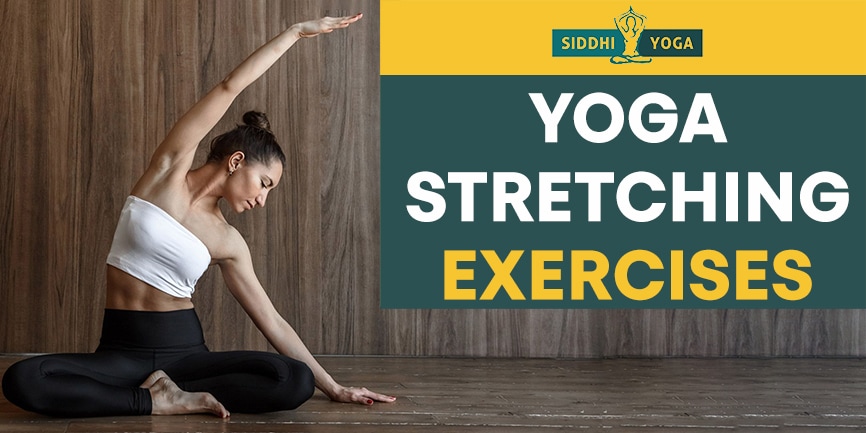
Morning yoga stretches
Everyone knows that practicing yoga will help with flexibility. What many people often tend to forget is that everyone needs a little extra help to open up the body, even the most advanced yogi. Hips, hamstrings, glutes, back, and shoulders are areas that specifically need to be stretched to not only help us with practicing yoga, but also everyday life. Stretching helps to promote mobility and good posture, while also strengthening the body.
No matter what level you’re at in your practice, it’s important to take the time to stretch your body both before and after your yoga practice. Here are some stretches that are great for yogis ranging from beginner to the most advanced practitioner to help you open up your body and prepare it before practicing more asanas (poses).
PART 1 – YOGA STRETCHES FOR BEGINNERS
This sequence of stretches was designed with the beginner in mind. They can be done on their own, or before a yoga practice.
1. Bitilasana (Cow Pose) and Marjaryasana (Cat Pose)
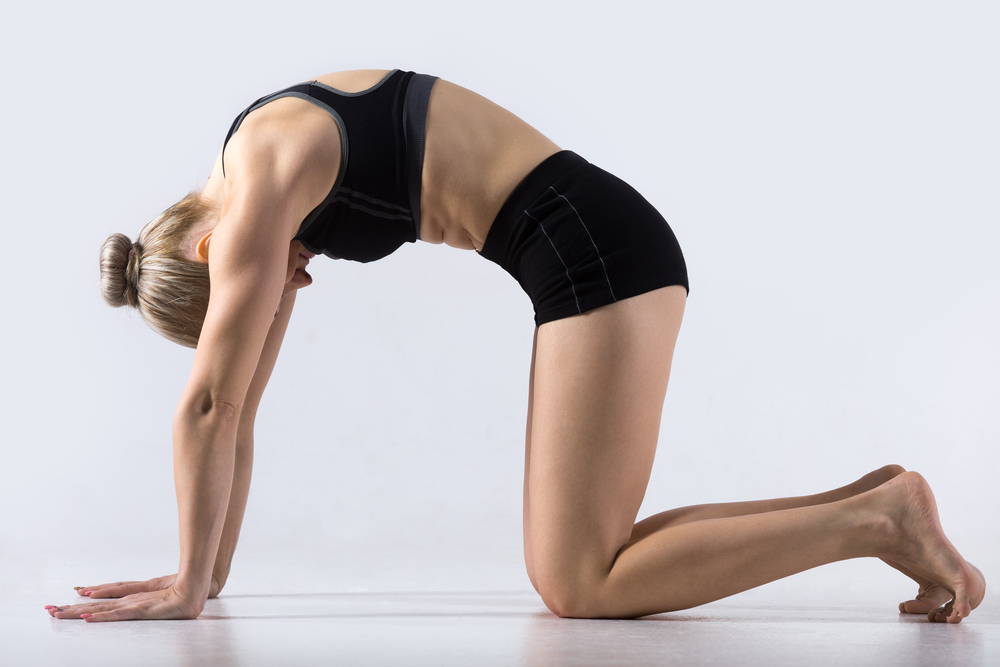
Start in a table top position. Make sure that your knees are hip-width apart and your wrists are directly under your shoulder blades, fingers stretched with middle fingers facing forward. These poses stretch the neck and the torso and are great for stretching the entire back. It also awakens the spine.
Inhale and bring your spine down and chin and chest up, keeping your shoulders back. Inhale and curl and stretch your spine, lowering your head. Do this three times.
2. Adho Mukha Śvānāsana Modified (Walk the Dog Pose)
From table top position, curl your toes under and exhale and bring your sit bones up to the sky in Adho Mukha Śvānāsana (Downward facing dog pose). Make sure your legs are hip-width apart and your wrists are under your shoulders. Your fingers should be spread with the weight distributed evenly through the palms of your hands.
Slightly bend one knee at a time, stretches the hamstrings, calves and glutes. This will also stretch the back of the heels. If you can’t touch your heels to the floor, then stay on your toes. Go back to Adho Mukha Śvānāsana, and then to table top. Stay in table top for 2 to 3 breaths.
3. Adho Mukha Śvānāsana Modified (Downward Facing Dog Modified)
Go back to the downward-facing dog pose. Bring your hands forward so that your back is stretched. Then bend both knees. This will stretch the entire back, shoulders and arms. It is also a great shoulder strength exercise. Finish in table top and stay there for 2 to 3 breaths.
4. Adho Mukha Śvānāsana (Downward Facing Dog Pose)
From table top, inhale and curl your toes under, exhale and straighten your legs, lifting your tailbone up. Make sure that your wrists are under your shoulders and your fingers are spread. You want the middle fingers to be facing forward parallel to each other.
Bend your elbows slightly so that your shoulder blades open up and your shoulders are away from your ears. Your head should be hanging, with no tension in your neck. Check that your legs are hip-width apart. This is an overall stretch. It also strengthens the arms, shoulders, core and back. Bring your knees down into table top and stay there for 2 to 3 breaths.
5. Balasana (Child’s Pose)
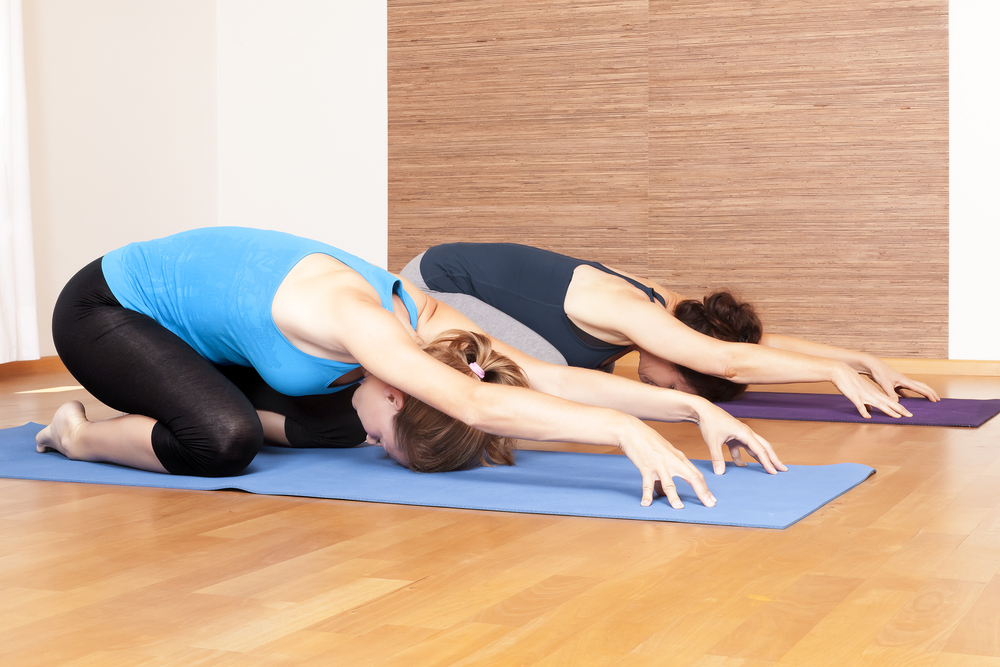
Next is a pose to open up your lower back. It is also a great stretch for anyone who sits for long periods of time throughout the day or needs to work on their posture.
From table top, bring your toes together and bed down, bringing your buttocks to your heels. Stretch your arms in front of you (extended) and place your forehead on the mat. If you can’t touch your heels, place a bolster or pillow on your calves. Go back to table top position.
6. Phalakasana (Plank Pose)
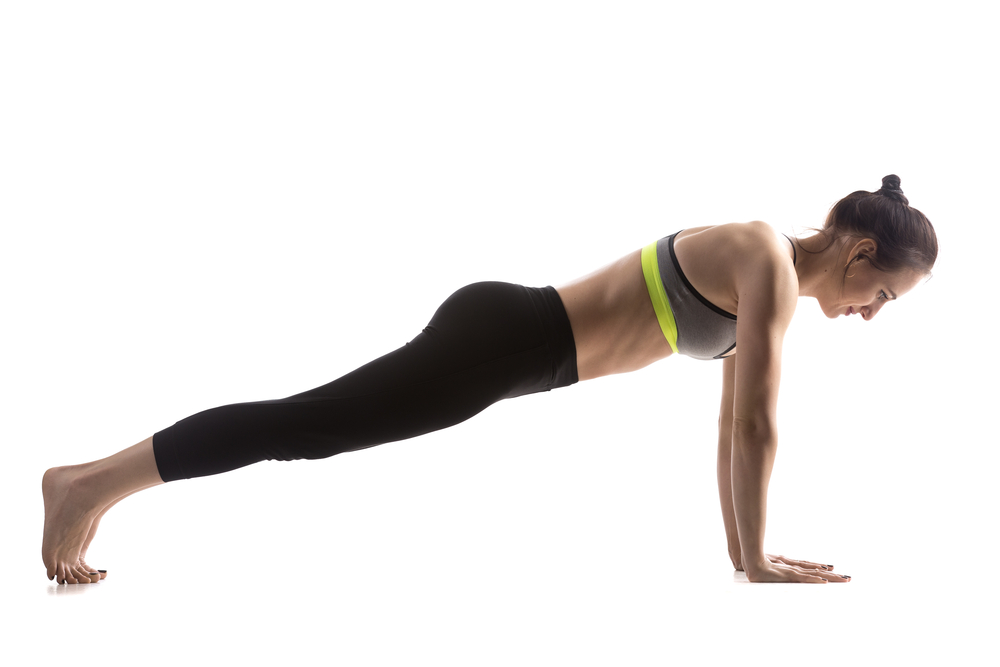
This pose works your abdominal muscles while also strengthening your wrists, arms, shoulders and shoulder blades. It is a great starter for arm-balancing asanas.
For this pose, make sure again that your wrists are under your shoulders and your fingers are stretched like in Downward Facing Dog Pose. Your shoulders should be open so that they are away from your ears.
Inhale and hold, exhale and contract your abdominal muscles. Do this three times, or more of you can. Then go back to the table top position and rest.
Inhale and go back to Plank Pose. Then bend your right knee and bring it to your right elbow, working the exterior oblique and transverse abdominis muscles. Do this three times, then go back to plank and do the same on the left side. Once you are finished go back to table top position.
7. Bhujangasana (Cobra Pose)
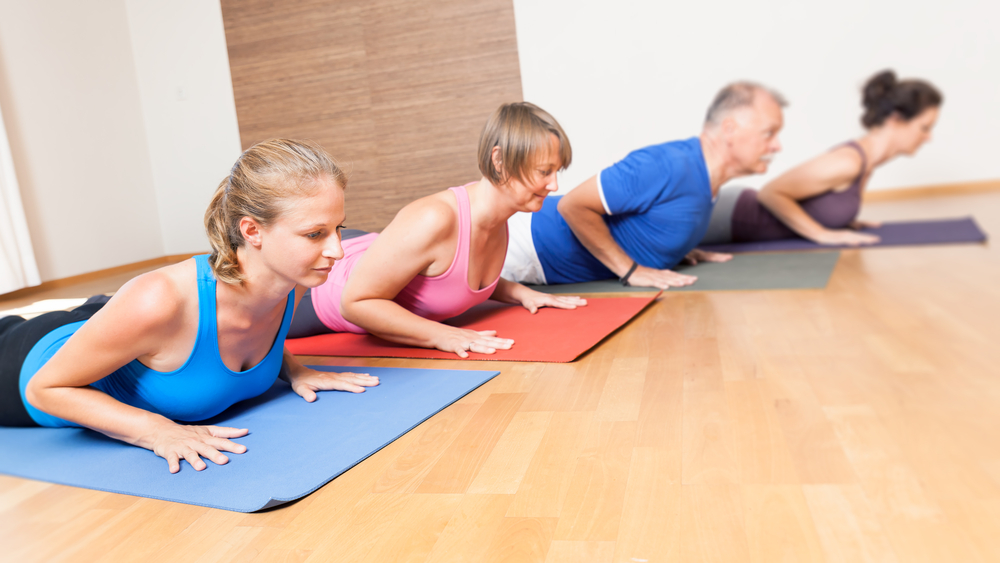
Now we are going to stretch the back and open up the chest. It is easy to get into Bhujangasana from Plank, as you simply bend your elbows and lie down on your stomach.
Place your hand under your shoulder blades with your palms on the mat. Make sure your feet are flat, with the toes pointed and top of the feet resting on the mat.
Inhale and lift your upper body up a little bit, keeping your torso on the mat. Exhale and come down. Do this 2 times.
Inhale and life your chest up a little bit higher off the ground. Exhale and lower yourself back down. Repeat this 2 times.
Inhale and lift yourself up again, trying to straighten your arms. Your hip bones should be on the mat. If they are coming up then bend your elbows, lowering yourself down a little bit. If you need to, you can go on to your forearms. Hold for 2 to 3 breaths.
Inhale and curl your toes under and exhale, lift your sit bones up to Downward Facing Dog Pose.
8. Tri Pada Adho Mukha Svanasana (Three-Legged Downward-Facing Dog Pose), Hip-Opening Variation
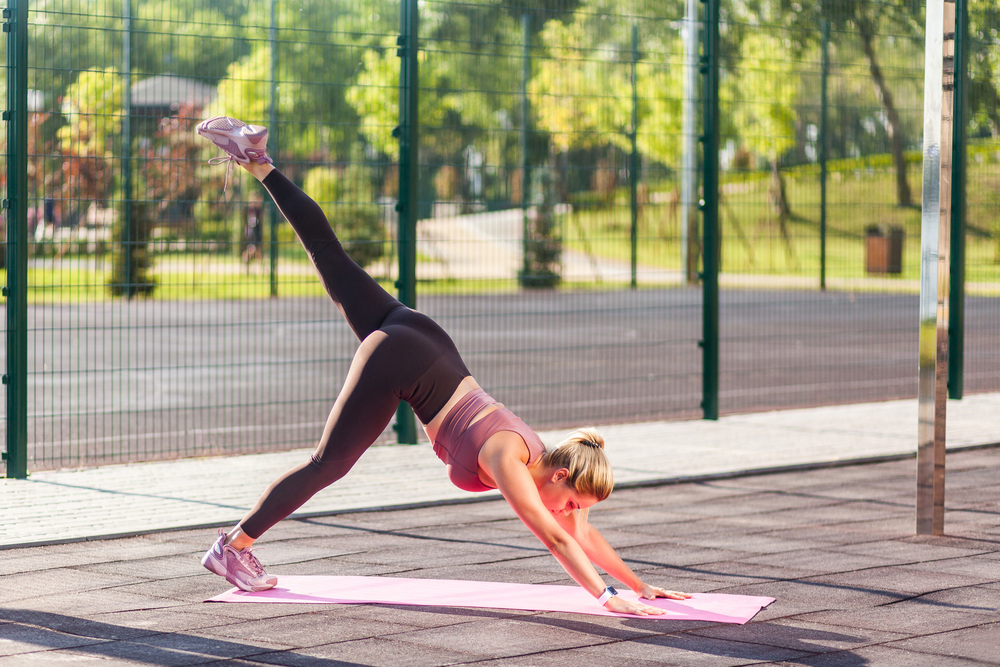
From Downward Facing Dog Pose, lift your right leg up to the sky and bend the knee, drawing the heel to the buttock. Then bring the knee to the left side, opening up your hip flexor.
Try to keep your shoulders squared and away from your ears. Use the abdominal muscles to help with balance, squeezing the navel into the spine.
Not only does this open up the hips, but it also stretches the side of the body and strengthens the shoulders, arms and wrists. Go back to Downward Facing Dog and do the same on the left side. Rest in Balasana.
9. Sucirandhrasana (Eye of the Needle)
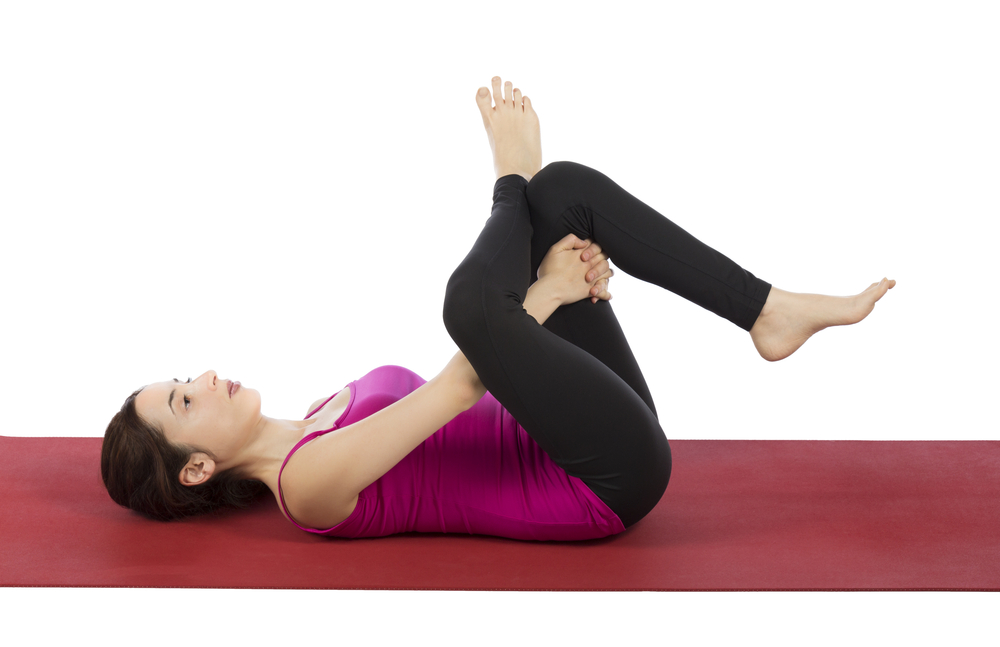
This pose is great for stretching the hips, groin and glutes. It is particularly good for people with knee or hip injuries, as it is a much less intense pose than other hip openers.
Lie on your back and bend your knees and place your feet flat on the mat around hip-width apart. Place your right ankle on your left knee and life your left leg up. Thread your right hand through the space between your legs and interlace your fingers behind your left leg.
Make sure that your spine is neutral and your head is on the mat. The backs of your shoulders should be comfortable on the mat and there should be no tension in the neck. Repeat on the other side.
Sucirandhrasana can be done with your leg straight or bent, whichever gives the best stretch in your hip.
10. Savasana (Corpse Pose)
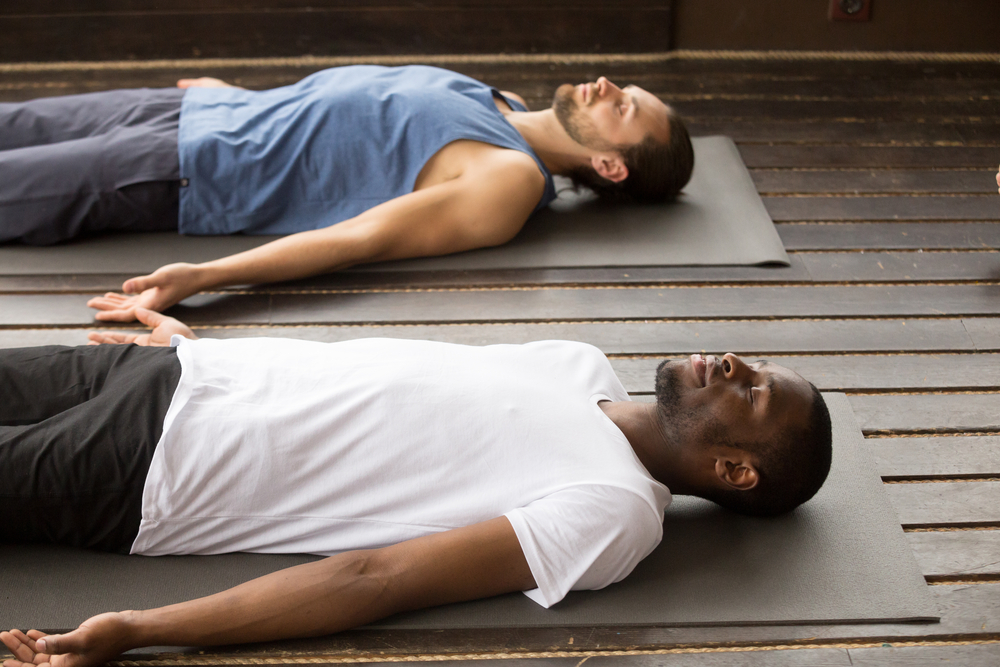
Lie flat on your back with your legs natural falling apart. Arms are at your sides with palms facing up.
This is a relaxation pose, and one that is well deserved after finishing any yoga sequence. Eyes stay closed and the body should feel heavy like it’s sinking into the mat. Stay here for a few minutes.
Then bring your knees into your chest. Bring your knees to the right and hold for 2 to 3 breaths. Then bring them to the left side.
You may also like: 200-Hour Yoga Teacher Training
PART 2 – YOGA STRETCHES FOR ALL LEVELS
This sequence of stretches can be practiced by people of all levels. They focus on the five main parts of the body that are important to stretch for practicing asanas.
1. Adho Mukha Śvānāsana (Downward Facing Dog Pose)
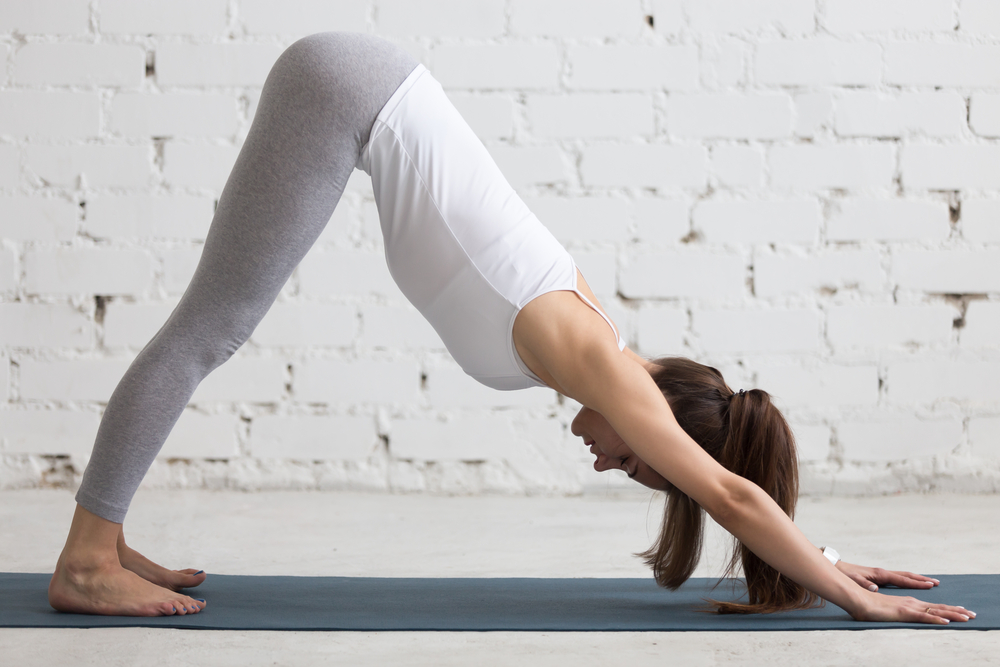
Go on your hands and toes and lift your tailbone up. Make sure that your wrists are under your shoulder blades and your fingers are spread. You want the middle fingers to be facing forward parallel to each other.
Bend your elbows slightly so that your shoulder blades open up and your shoulders are away from your ears. Your head should be hanging, with no tension in your neck. Check that your legs are hip-width apart.
Make sure that your weight is distributed evenly throughout the palms of your hands and the soles of your feet. If you have lower back pain then turn your big toes in towards each other.
Inhale and lift your heels up, stretching the back of your ankles and legs. Exhale and bring your heels down and toes up. Do this 3 times.
Bend your left knee to stretch your right hamstring. Then Bend your right knee to stretch your left hamstring.
Look up and slowly walk your feet to your palms. Grab hold of your forearms and let you upper body hang. Your shoulders should be open and away from your ears, neck hanging and relaxed. Weight should be distributed evenly throughout your feet.
If the stretch is too intense then slightly bend your knees. Stay in this position and slowly move from side to side for 1 minute.
2. Utthita Ashwa Sanchalanasana (High Lunge Variation)
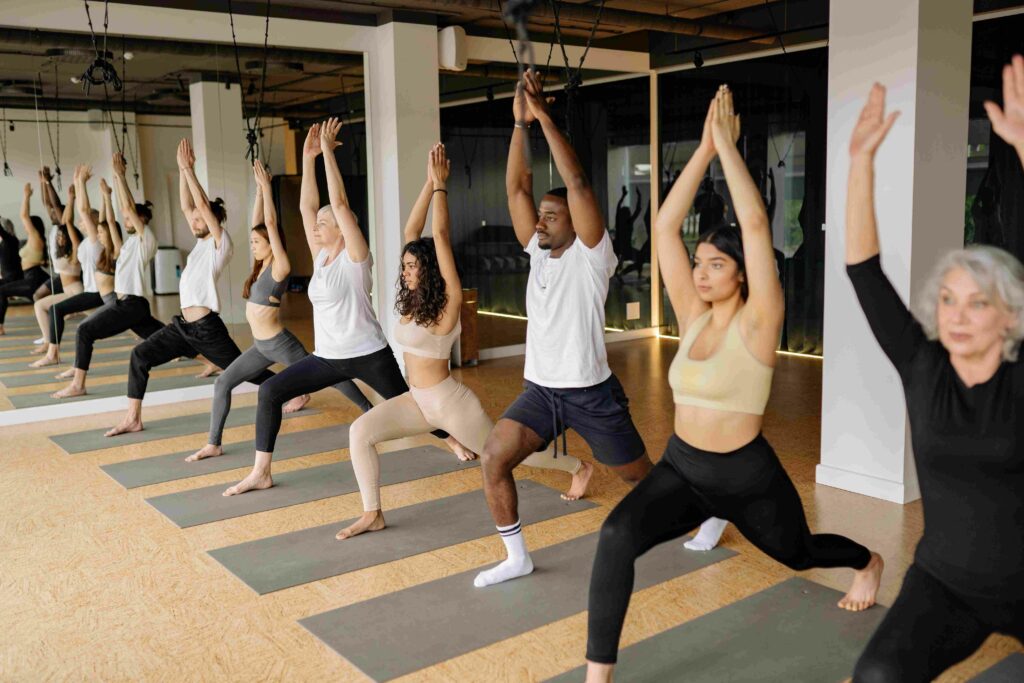
Bring your hands down and step your right leg back, bending your left knee. Make sure that your knee is in line with your ankle to protect your knee from injury.
Put your fingers down on either side of your left foot in a cupped position. If you can’t reach the floor than use blocks.
Lift and open up your chest and hold for 1 to 2 minutes. Make sure that your right heel is up. This pose stretches your right hamstring and also stretches the left hip flexor and glutes.
3. Ashwa Sanchalanasana (Equestrian Pose)
Place your right knee down, keeping your left knee bent with your ankle in line with your knees. There should be no pressure on your right leg.
Your fingers are cupped and on either side of your left foot. Open up your chest and your shoulders. Stay here for 1 to 2 minutes.
4. Anjaneyasana (Low Lunge Variation)
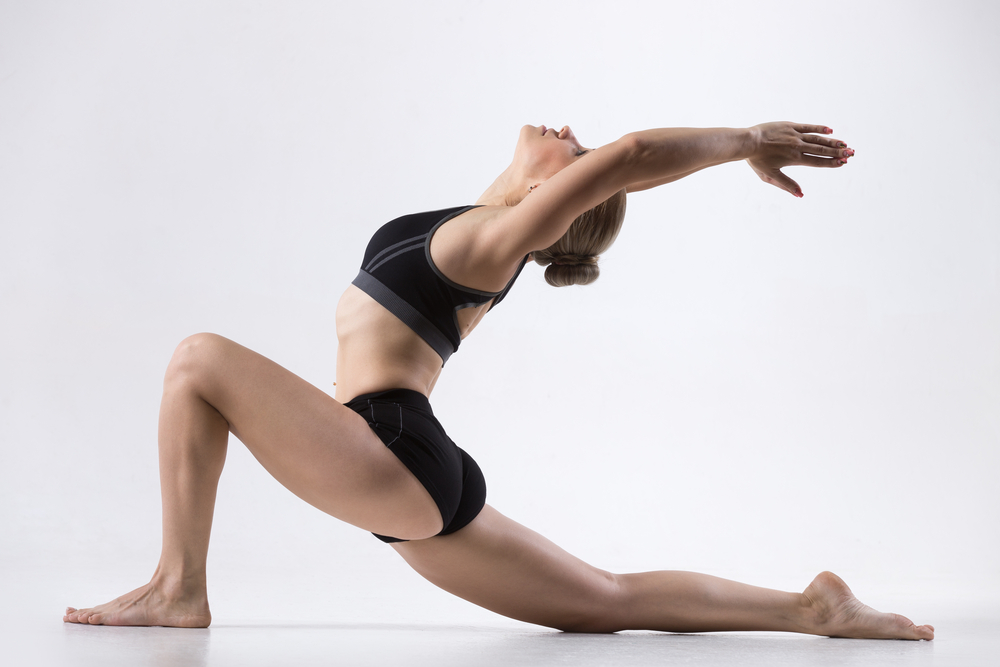
Move your left hand to the right side of your foot. Lift and open up your chest. Keep making sure that your left ankle is under your left knee.
For your right leg, press the top if your foot towards the earth and the back of your knee towards the sky, keeping the leg strong.
This low lunge variation stretches the thighs and groins, while also opening the chest.
Then bring your forearms down onto the mat or on a block if you can’t reach. Inhale and lift your head up, opening up the chest. Stay here for 1 to 2 minutes.
5. Adho Mukha Śvānāsana Variation (Downward Facing Dog Pose Variation)
Place the palms of your hands on the mat and step your left leg back to Downward Facing Dog Pose. Start bending your knees and stretching your back.
Try to move your chest close to your thighs to stretch out your back as much as possible.
6. Eka Pada Rajakapotasana (Pigeon Pose)
Straighten out your legs back to Adho Mukha Śvānāsana. Bring your left leg in front of you into an L-shape, right leg straight behind you to Pigeon Pose.
This is a fantastic hip-opening pose that also stretches the glutes. Thighs are rolling in and hips going forward, square to each other.
If the stretch on your left leg/knee is too intense then bend it in more, bringing your heel closer to your body.
Inhale and open up your chest, exhale and fold forward. Cup your fingers and place them on the floor above your head, forehead on the mat.
If the stretch is too intense, walk your hand towards you, go on your forearms or place the palms on the mat in front of you with your arms straight. Hold and enjoy the pose.
Push on your right leg and bring the left back to Downward Facing Dog.
Do steps 2 to 6 on the right side.
7. Balasana (Child’s Pose)
From Downward Facing Dog, bend your knees to stretch your back and bring them on to the mat, placing your big toes together. Sit on your heels in Child’s Pose.
Bring your fingers into a cup shape to activate the pose. Shoulders should be open and back straight. The forehead should be on the mat or on a block.
8. Urdhva Mukha Shvanasana (Upward Facing Dog)
Inhale and bring your head up and place your palms on the mat. Bring your chest down and push yourself forward and up to Downward-facing Dog.
Only the tops of your feet and your hands are on the mat. The rest of your body is raised. Make sure your shoulders are open and down away from your ears.
Look up and open up your chest. Make sure not to throw your head back, as this can throw out your lower back.
Exhale and bring your knees down and back to Balasana. Repeat five times.
9. Balasana Variation (Child’s Pose)
Come up to table top pose. Then place your forearms on the mat. Extend your forearms forward to feel your armpits stretching and interlace your fingers.
Push yourself back and place your forehead down. This stretches the back, shoulder blades and hips. Make sure that your knees are in line with your hips.
Raise your hands up above your head, keeping your fingers interlaced. Stay here for 6 breaths.
Exhale and bring your forearms back down, inhale and bring them back up. Do this 15 times. If you have a block, you hold the block instead of interlacing your fingers.
10. Parsva Balasana (Thread the Needle Pose)
From table top pose, extend the right arm forward and inhale and bring the left arm to the side. Inhale and bring your left arm through to the right side, placing your arm and head down.
Bring your right arm up over your head, fingers cupped on the floor. You can also bring the right palm on a block or on your hip.
Stay for 6 to 8 breathes. Then push the floor and come back up to table top and do the other side.
11. Sukhasana (Easy Pose)
Sit comfortably cross-legged, with your back nice and straight. This is a relaxation pose that is often performed during meditation.
Bring your arms to your sides and go onto your fingers (cupped). Bring your left arm up on the inhale and exhale and bring it over to the right side, moving your right hand out away from your body.
This stretches the entire left side of the torso from your hip all the way up to your armpit. Inhale and bring your left arm back up, exhale and bring it back down. Do the same for the right side.
12. Savasana (Corpse Pose)
Lie and rest in Savasana, relaxing your entire body. Stay here as long as you would like.
Finish the sequence by going back to Sukhasana, close your eyes and take one long inhale and one long exhale. Bring your palms together at the heart centre and open your eye.
CONCLUSION
These stretches will help you get your body ready for a yoga practice or just recover from one. Incorporate them into your daily practice and begin to see the difference in your overall flexibility, strength and posture.
Elevate your well-being with our Online Yoga Courses! Join expert-led virtual classes, enjoy flexible schedules, and explore various yoga styles. Embrace personal guidance, connect with a supportive community, and access recorded sessions anytime. Start your transformative journey today!
What are some of your favorite yoga stretches? Let us know in the comments!
Check out our other post:
Responses